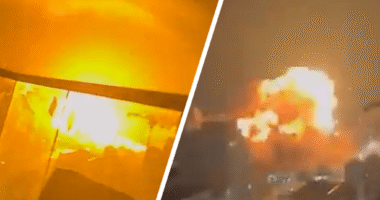Highly contagious whooping cough has surged to levels in the US not seen in over a decade.
Whooping cough, also known as pertussis, is a respiratory infection that can be deadly and causes intense coughing spells that are so severe they can lead to rib fractures. The characteristic ‘whooping’ sound comes from the chest during recovery from these fits.
Recent government data has shown a significant increase in reported cases of whooping cough, with numbers more than doubling since mid-September. In addition, cases of walking pneumonia among toddlers have soared seven times higher since March, and have doubled among older children.
The CDC confirmed more than 32,000 cases of whooping cough in 2024, a massive increase from the 6,500 cases confirmed in 2023.
The CDC has also noted a rise in walking pneumonia cases in the US across all age groups from March to October 2024, reaching a peak in August. Children saw the largest increase, with rates spiking from one percent to over seven percent in ages two to four, and from almost four percent to 7.4 percent in ages five to 17.
Approximately a quarter of whooping cough cases have been recorded in Midwest states, including Illinois, Indiana, Michigan, Ohio, and Wisconsin. Pennsylvania currently leads the nation with the highest number of reported cases.
Public health officials have come to expect spikes in pertussis cases every few years, but the Covid pandemic, during which millions of people were isolated and shielded from other infectious diseases, offered a rare respite.
Now, trends suggest whooping cough levels are returning to pre-pandemic levels, all while childhood vaccination rates have shown signs of falling.
The vaccination rate among kindergarteners was about 92 percent for the 2023-2024 school year, below the 93 percent coverage for the previous year. And the exemption rate for kindergartners increased to 3.3 percent, the highest ever reported in the US.
The infection can be fatal, but rarely so. Fewer than 20 people on average die of pertussis annually.

The CDC confirmed more than 32,000 cases of whooping cough in 2024, a massive increase from the 6,500 cases confirmed in 2023

In addition to causing severe, sometimes rib-cracking coughs, pertussis leads to fevers, congestion, a whooping sound when inhaling, vomiting, fatigue, and sore throat
At the same time, parents and pediatricians nationwide are reporting upticks in walking pneumonia, a bacterial infection that can cause excessive coughing, but normally does not leave patients unable to carry out their daily tasks.
The rapid spread of walking pneumonia, or mycoplasma pneumonia, is believed to be due to its mild initial symptoms — such as a cough and slight breathlessness — allowing people to spread the infection while remaining active and walking around.
But it can be severe for infants and children. It has led to more children being hospitalized, which experts say may be linked to Covid lockdowns blocking children’s exposure to good germs and, as a result, weakening their immune systems.
In addition to increased hospitalizations due to mycoplasma pneumonia among children, the CDC has reported a rise in infections across all age groups.
Firm figures are hard to come by, though, because there is no national reporting or surveillance system for mycoplasma pneumonia infections.
Whooping cough can be a serious infection for people of all ages, but infants under a year old are particularly susceptible due to their underdeveloped immune systems.
In addition to causing severe, sometimes rib-cracking coughs, pertussis leads to fevers, congestion, a whooping sound when inhaling, vomiting, fatigue, and sore throat.
The Tdap vaccine is highly effective at preventing a life-threatening respiratory infection if given at the right schedule: 2 months, 4 months, 6 months, 15–18 months, and 4–6 years.
Although the number of cases of the infection has risen sixfold since 2023, a survey from the Annenberg Public Policy Center of the University of Pennsylvania shows a wide gap in knowledge. One-third of respondents didn’t know what pertussis was or that there was a vaccine to protect against it.
Whooping cough is generally considered a pediatric disease.
People generally believe that childhood vaccinations offer protection for life, ‘which is completely not true,’ according to Dr Tina Tan, a pediatrician at Ann & Robert H. Lurie Children’s Hospital of Chicago.

Pneumonia causes white spots or opaque areas appearing in the lungs. The above patient was a 57-year-old man in 2014

Health officials warned that the infection is initially difficult to tell apart from a cold, as the first signs are a runny nose and sore throat. But around a week later, sufferers may develop coughing bouts that last minutes, struggle to breathe after coughing and make a ‘whoop’ sound between coughs
She added ‘adolescents and adults serve as a major source of transmission in the community’ because their immunity has waned greatly since childhood. They themselves may not get severely ill, but they’re highly effective transmitters of infection.
Cases generally increase every three or four years, and public health officials are not necessarily surprised by the massive spike that disease monitors have recorded.
That tri-annual cycle was disrupted with the onset of mass masking and quarantine measures to protect from Covid, which stunted the pathogen’s ability to spread from person to person as easily (through respiratory droplets blocked by masks).
Public health officials believe the uptick signifies a return to normalcy.
Dr Timothy Lishnak, a family medicine specialist at the University of Connecticut, said: ‘It’s considered an endemic infection, meaning we’ve been coexisting with it for quite some time, as opposed to COVID, which was an epidemic virus, new on the scene.
‘And as we start to get people back into contained areas and getting back into school and other facets of life, you see this spread because it’s spread by breathing out and breathing in the bacteria. So that’s one of the mechanisms that it starts to increase.’
At the same time, parents say doctors are struggling to diagnose the condition on time, often writing it off as a viral infection, a cold or the flu — which delays timely treatment for children.

Whooping cough rates are rising nationwide, but rates were highest in Pennsylvania with over 2,087 cases, followed by New York with 1,781 cases and Illinois with 1,058
Pertussis was a significant cause of childhood death in the early 20th century, but that changed with the debut of a vaccine in the 40s. Before it became widely available, there were about 200,000 cases of pertussis annually.
From then through the 1980s, the number of cases per year has decreased more than 90 percent compared with the pre-vaccine era.
However, cases began increasing gradually after the tail-end of the 1980s, eventually peaking in 2012 with 48,277 reported cases. Since then, case numbers have stayed relatively high until the onset of the pandemic in 2020.
Several factors likely contributed to the increase in reported pertussis cases, including improved awareness and recognition of the disease by healthcare providers, greater availability and use of laboratory diagnostics for confirmation, enhanced public health surveillance and reporting systems, and waning immunity associated with the pertussis vaccines.

















